
- the world's friendliest SWAT officer, who kept waving at me for stopping as he crossed the crosswalk
- obligatory yet welcome T-rexes
- very alert French bulldog (not a costume)
- Link w/ spiffy plastic shield & Master Sword
- more homemade Link with no spiffy shield but no less spirit
- twin ravens
- Among Us crewmate/impostor
- walking vampire teeth (bottom row only)
- dragon mask with homemade coat of gradated autumn leaves (supposedly the Green Man as per a later conversation, but I'm not seeing it)
- rainbow Romany girl
- homemade Cruella de Vil complete with branded Dalmatian bag
- twin parrots
- female berserker w/ fur boots
- traditional princess w/ impressive pink taffeta meringue-whip skirt
- deer bride (? woman in white dress w/ antlers)
- little girl steampunk engineer
- black & red dragon (not original, but the costume was really well-made; a well-formed fuzzy head, like a stuffed animal, with a warm cape just the right length)
- inflatable dragons; more of these than T-rexes
- Black Widow
- hot dog w/ relish ruffles on sides (overheard: "Don't pull on Mom's mustard!", even though Dad was wearing the costume; this was never explained)
- young surgeon (female STEM representation very strong this year)
- inflatable...badger? wolverine? it had sharp claws
- zombie, and that's not original, but the kid kept yelling "BRAAAAAIIIINS!!" and was impressively committed
- either an owl or No-Face from Spirited Away (this was just a mask with a short fuzzy white blanket draped from it and worn on some sort of support seated on top of the head, and while it was extremely lazy, points for originality)
- neat looking knight in faux chain mail & a red tabard plus full-face black hood/visor
- neat green fairy (Tink? absinthe personification?) with pointed wings lit w/ fairy lights
- pharaoh
- an adult wearing Pinhead's coat but not anything else Cenobite?
- someone with just a literal jack o' lantern on their head
- an older girl with elf ears, a crown, and a red cape, black vest, and white shirt; she looked good, but I got the feeling that she was someone specific and I couldn't identify her
- another homemade Cruella de Vil with a fur jacket spray-painted red on the back (maybe this happens in the new movie; I don't know)
- father in Día de los Muertos makeup & a sombrero + daughter in beautiful black & aqua Mexican-inspired princess dress
- a couple Beetlejuices, which is odd, since they were kids who should be way too young to recognize the character; they must just like his style
- inflatable BB-8 with old-school Leia (but blonde)
- a black-clad superhero whom I thought might be Black Bolt but who had some inverted-triangle symbol with vertical lines on top I didn't recognize and can't look up
- twin Scooby-Doos
- family of shiny green dragons w/ fabric wings (2 women + child)
- another female berserker (w/ skull skirt this time - to balance out all the STEM?)
- an ostrich
- little twin firemen, parents dressed as a burning building and hydrant, and a stroller doubling as a fire engine (w/ real light-up headlights)
- sentient rainbow with neat rainbow gradient light-up cape
- another deer bride, what the hell (is this a Midsommar thing?)
- guy wearing plastic molded full-head bluebird mask?
- businessman w/ head being eaten by shark
- something inexplicable: a dad dressed up as a raccoon with a daughter dressed in gray and a sandwich board saying "ROCK"? ????
- Eli Wallach from A Fistful of Dollars (this was a kid)
- glitter shark
- female lineworker
- Chica from Five Nights at Freddy's (FNaF costumes were all over a few years ago; fairly unusual now)
- tons and tons of neon light-up LED Dead by Daylight Legion-like masks with X-ed-out eyes and sewn-up mouths; it couldn't have been Legion, because they were so popular - there were literally dozens - but they looked neat
- inflatable rainbow unicorn
- a flamingo
- either just Zorro with a long, full beard or practicing Orthodox Zorro
- an older kid in a black robe holding just like a hobbyhorse unicorn head in front of him; I don't know if this was meant to communicate that he had beheaded the unicorn - the message was unclear
- evil Ralphie from A Christmas Story in his rabbit jammies w/ a bloody baseball bat
- Slipknot-loving unicorn in band T-shirt (as this unicorn passed, a kid called out: "there are so many unicorns!")
- man with just a literal tree branch tied with rope to his back
- Amanita mushroom

Mini Motorways
Gameplay: Connect neighborhoods with shopping centers, workplaces, and other destinations to keep traffic moving on your highway network.
How is it?: I've platinumed the predecessor to this game, Mini Metro, despite the devs constantly trying to take that away from me by issuing new levels six years after release. It's not an exaggeration to call Mini Metro an all-time classic, turning the iconic art of subway maps into a satisfying game of transportation line management combining long-term planning with rapid responsiveness and thinking on your feet.
This doesn't measure up, and it's primarily because, bluntly, the flow of traffic cheats. Locations seem to spawn their own artificial "demand" for motorists independent of your population, and you can lose through no fault of your own just because the map hasn't spawned enough of the right type of houses. In one game, I had a direct expressway connecting the only neighborhood in one category right to the doorstep of its only matching destination, and the destination still timed out. There was literally nothing I could do.
The game design is also littered with careless, aggravating dead ends, like the traffic lights that are utterly useless or the houses that spawn in the stupidest, most wasteful locations and orientations or the roundabouts that facilitate traffic flow in a way that real roundabouts don't but that require room you'll never have in the busy locations where they could actually help. It's just not as smart or tightly-designed as its predecessor - or as successful puzzle games in general, for that matter. It looks purty, but avoid.
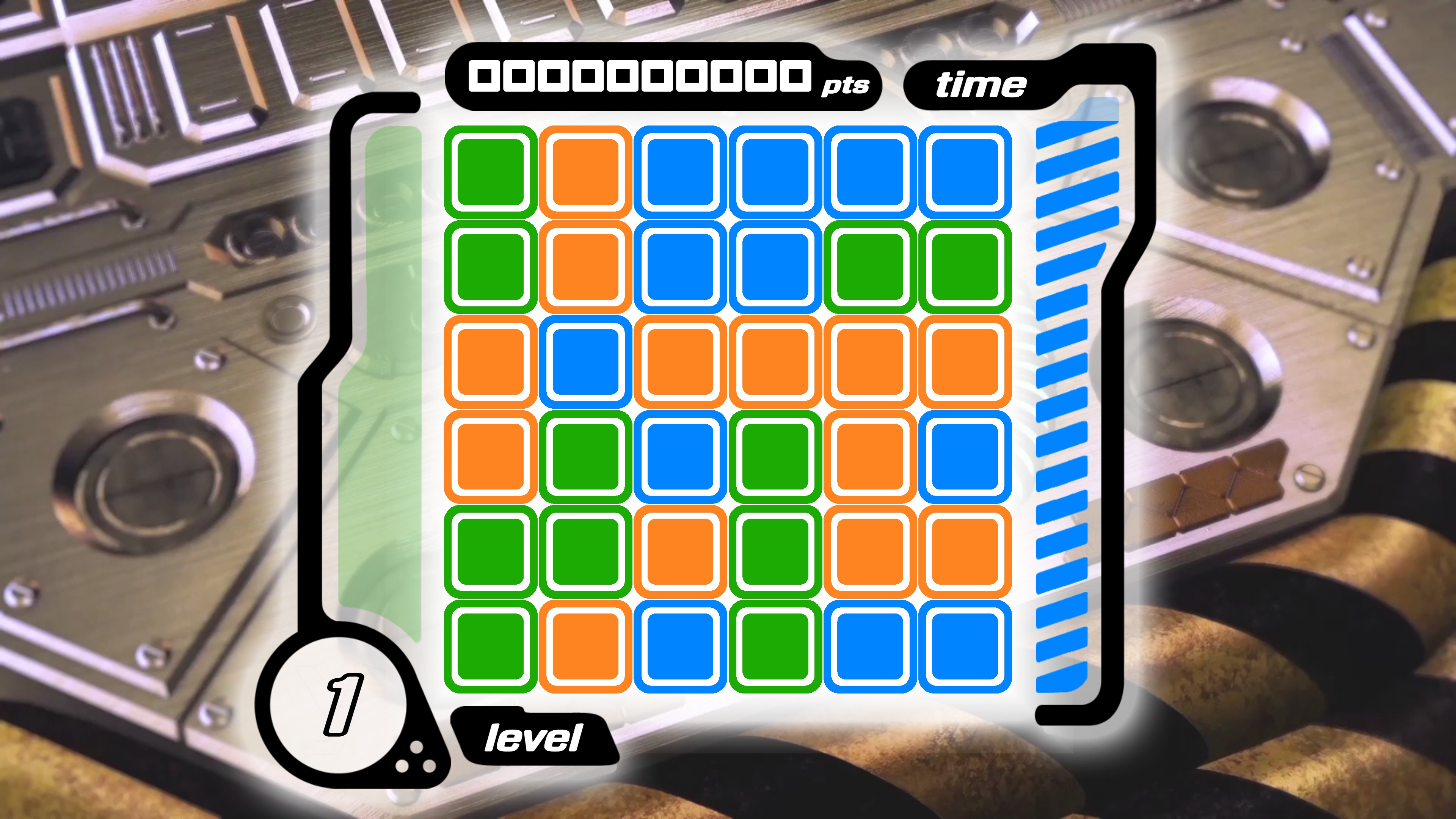
Crossniq+
Gameplay: Connect tiles of the same color to form crosses on a 6x6 grid by shifting entire rows & columns.
How is it?: It has a heavy 2000s-era Lumines vibe with its clean interface and photorealistic backgrounds, which I dig, and the gameplay isn't bad, either. I just wish there were more single-player content: more modes, more unlockable BGM tracks, more colors for the tiles. The special-ability tiles are reserved for local multiplayer only, and the Coloris-style shifting tile graphics appear only in an aimless scoreless mode. The game could use more than one background, too. And you can't play against an AI. This isn't a bad diversion for a couple hours, and I appreciate the effort, but both the presentation and the gameplay could use further exploration.
(That said: I suspected, given the polish in what is present, that the missing content was due to a lack of manpower and possibly a solo dev, and an AMA proves that hunch correct. Here's hoping that the dev gets the funding for an update or sequel with that story mode and single-player versus.)

Link-a-Pix
Gameplay: Connect matching numbers on a Picross grid using lines composed of the same number of squares to form nonogram art.
How is it?: The puzzles are huge, colorful, and well-drawn, and you get a ton of them, particularly for the price. If you like illustration-based number logic puzzles but want a variant from Picross, you won't go wrong with this. The only problem: a couple pages in, the puzzles start taking 45+ minutes to complete. Not great for those of us looking for just a quick puzzle hit. (But there are DLC packs of shorter puzzles to fix that problem.)
Dark Fantasy Jigsaw Puzzle
Gameplay: Connect jigsaw puzzle pieces to reveal van art breasts.
How is it?: This is a jigsaw game for people who just want to kind of half-ass playing a jigsaw game. You see the art blurrily beneath the assembly field and can just sort of drop a piece in the general vicinity of its spot to fit it in. Look, intellectual rigor is not exactly this title's selling point:

Well, that's not a screenshot. Actually, I didn't take many screenshots, because I found out soon after purchasing that all the art is just available as .pngs in the game's steamapps folder. And, actually, that shot's misleading, as most of the women aren't as tastefully clothed as female Julious up there. Here's the only screenshot I bothered to take, of the last puzzle, which is more representative of the title:
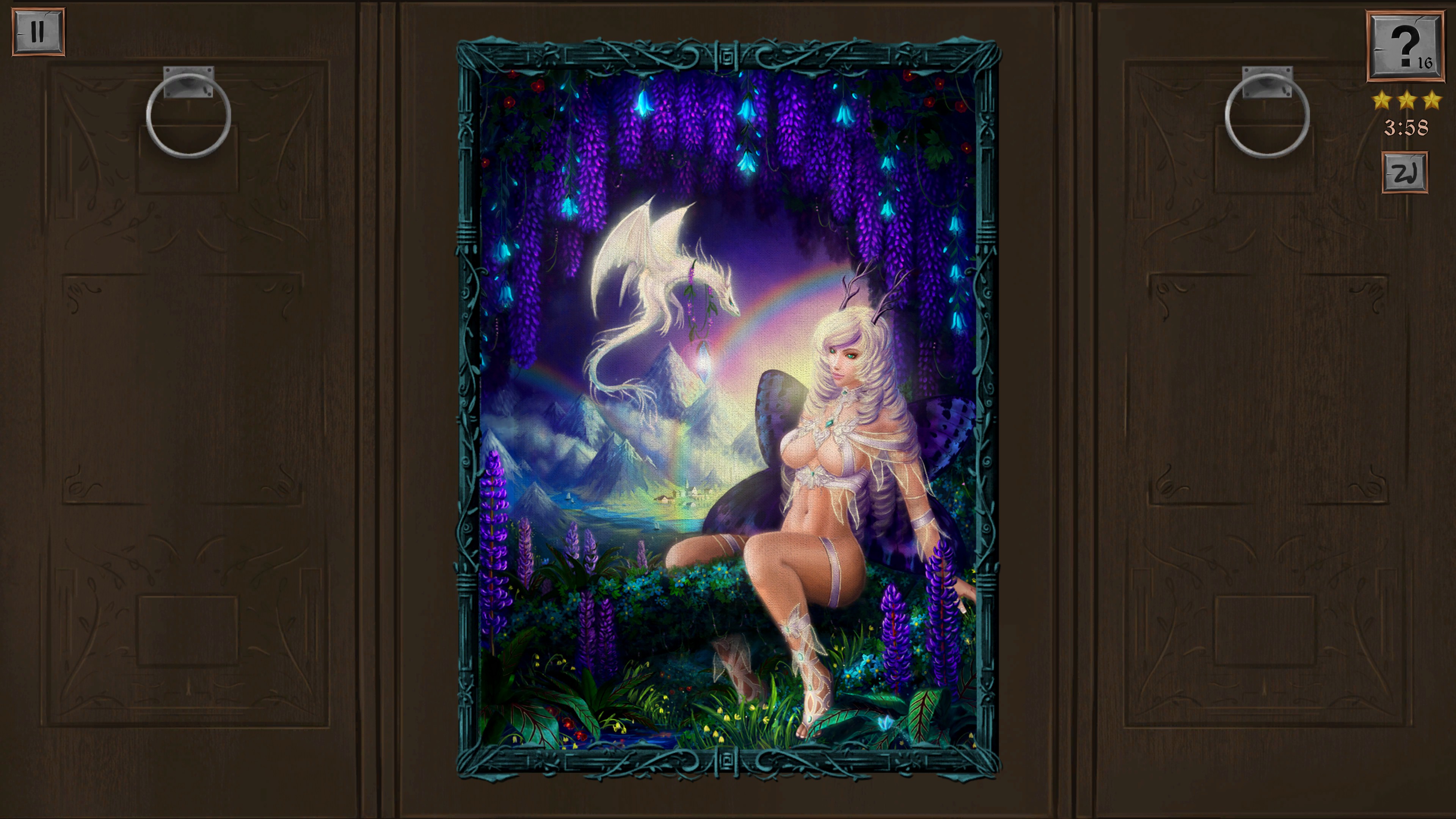
All right, not all of it is that far, either. Split the difference between the two, weighted toward the latter example. I don't know exactly why I purchased this, jokes about my own potential obliviousness aside. Some things are mysteries. It's not the sort of purchase I can recommend, but I'd be lying if I didn't say I didn't have a bad time with it. If you're in the mood for this type of art, you might want to hit up the artist's page. (Also, since commission pricing has been a hot topic around here, those commission tiers are eminently reasonable given the work involved.)
I've been having a pretty good day. I'm actually on the road, touring the great postage stamp that is the Ocean State, seeing its little-visited western half. On the way, I got some photos of this gorgeous marsh ringed by peak-autumn foliage by with silvery pampas grass in the foreground and lilies on the surface - just a stunning contrast. I note that my first day's destination is near Mystic, CT, where I had a memorable day trip with my father when I was a kid, so I nabbed what turned out to be a good hotel room at a reasonable rate, went downtown, ate at Mystic Pizza (veg pie, could used more salt), had a delicious lemon-choco-chunk and Indian pudding ice cream cone, and so enjoyed window shopping that I've decided to stay tomorrow, see the aquarium, and tour Mystic in earnest. I snagged a replacement charger for the one I forgot to bring from home so I could relax with a little Dead by Daylight and the brand new tome with cosmetics for my beloved Yun-Jin and Trickster (man, that is a Blanche Devereaux starter outfit they gave Yun-Jin - which is fine for Blanche, but not for Yun-Jin).
Then I'm getting into bed, and I think, oh, wait! In the rush out the door this morning, I forgot not only my laptop charger but to check Akari Funato's Skeb! I didn't expect commissions to reopen so soon, but to my delight, I find - success! She's Seeking once more. At last, the hour is at hand...to correct the error of my stupid bank from...what was it, a week ago?
I see, though, that the suggested starting bid for a commission has gone up significantly - from 20,000 yen to 33,000 yen. That's...a lot. Furthermore, I had put a significant bonus on top of my initial bid to attract attention and maybe a little extra detail in the work. I can't afford that bonus now - the minimum's a hefty ask as it is. I won't have an attention-grabbing bid, and I can't guarantee an extra-nice piece. But, you know, the heck with it! I'm still cursing my bank under my breath for not getting in at a lower price point, but this is a once-in-a...well, not lifetime, but a several-months purchase, at least. An Akari Funato image of Morris in 2021 is still worth a hefty price to me. It's been a long day, but I'm ready to babysit this commission and/or bug my bank - all night, if need be! All right, at least until 2 or 3. I sign in, fill in my request, hit "Submit," and...
I'm greeted with another error message. Not remotely the one I expected, though.

Please submit an offer of at least 60,000 yen or try revising your request.
60,000 yen. That's over $500 U.S. as of this writing. What I feared happening seems to have indeed happened - requests for Lunar work (Vheen Hikuusen in particular) started coming in after the Ghaleon piece, Funato took umbrage at being pigeonholed by her Lunar stuff as she was back in the '90s, and so she set a price high enough to deter anyone from making the requests in the first place. I doubt getting my request in last week would have mattered - she takes offense to being asked to do Lunar stuff at all, even of her own creation. Even if I were in a position just to burn $500+ outright, if an artist doesn't want to do a request, you're not going to get a good piece.
Even though I love Vheen Hikuusen to death and think it's absolutely Funato's masterpiece, I understand her frustration with being identified with a work that's part of another creator's franchise instead of her own stuff. I think I would have had more respect, though, if she had just refused requests with "Lunar" or "Vheen"/"Vane" in them outright rather than charging double for a begrudging commission. For $500, I could get a lot of fan art from fan artists who would most likely put more love into the final product. I'm happy that Skeb is working out for Funato, but at this point, I'd rather give that money to someone else.
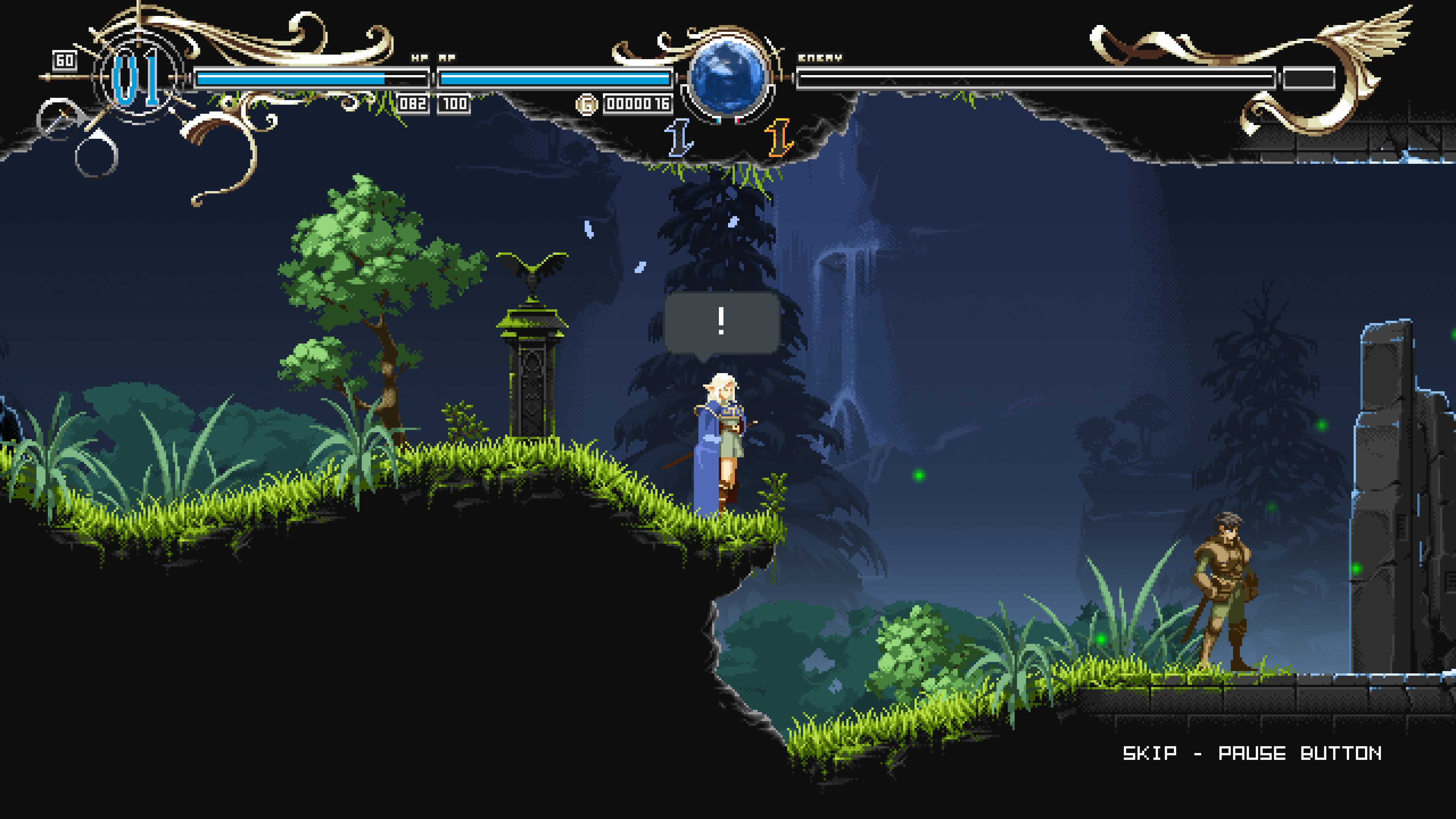
Despite being one of the big guns of anime when I was getting into the medium, I don't think I've ever seen Record of Lodoss War, not properly. It aired regularly on the Sci-Fi Channel during its attempts to introduce anime to broader audiences in the mid-to-late-'90s, and I remember catching bits and pieces: the omnicompetent elf Deedlit's first meeting with the young knight Parn, upbrading him for causing a big clumsy human ruckus when "there are fairies in these woods," and what I believe was the opening scene, of the six heroes moving silently under cloaks in a rainstorm, à la the intro to Clock Tower: Ghost Head, albeit concerning less-nefarious business. I remember an upscale video catalog dedicated primarily to British programming featuring the Lodoss box set, trying to showcase anime to its patrons as "the hottest new Japanese import" (unfortunately, it must not have taken, as the box sets were on clearance a few months later). I remember the Dark Knight Ashram, a fan favorite of so many, and someone on some forum or fanzine coining the term "Parn syndrome" to refer to bland, not-very-capable heroes who were blatant stand-ins for the target shounen audience able to trump far more interesting and powerful villains through author fiat. (I would have termed this "Alex syndrome" myself.)
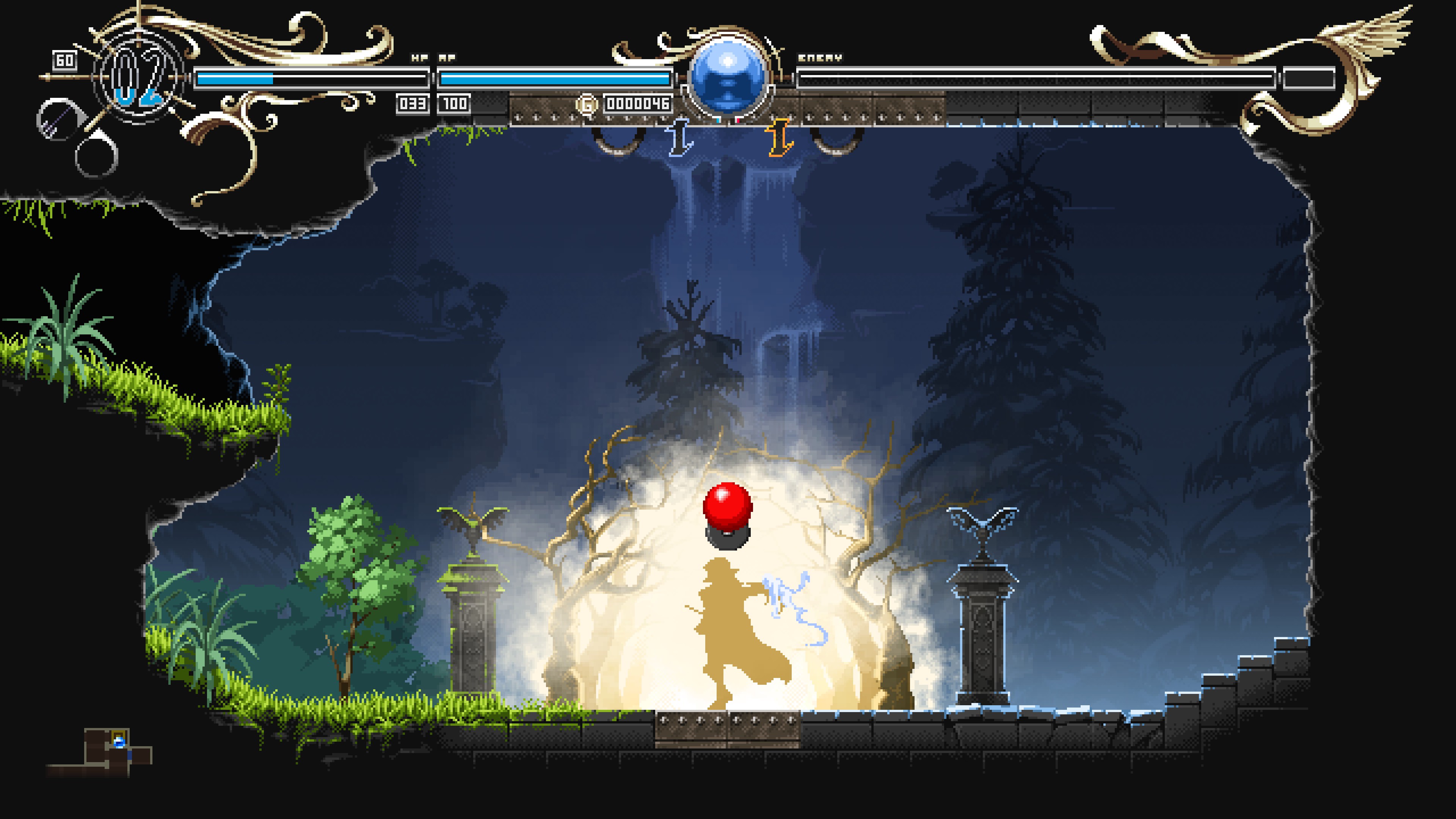
What drew me to Deedlit in Wonder Labyrinth, and ultimately convinced me to purchase it during the latest Steam sale, was the game proudly putting Deedlit front and center in its promotion, the game icon consisting of a glamorous, unabashedly loving illustration of Deedlit bathed in sunlight. Deedlit was a top-tier waifu in the '90s, and I outright goddamn admire the creators going, "You know what? We still love this character! This character is good, and she deserves a starring role in her own video game, vagaries of time and franchise popularity be damned!" Hell yeah! Go ahead! Bring on Ghaleon in Wonder Labyrinth. If my enthusiasm seems inconsistent with recent comments I've made, hang on a bit.
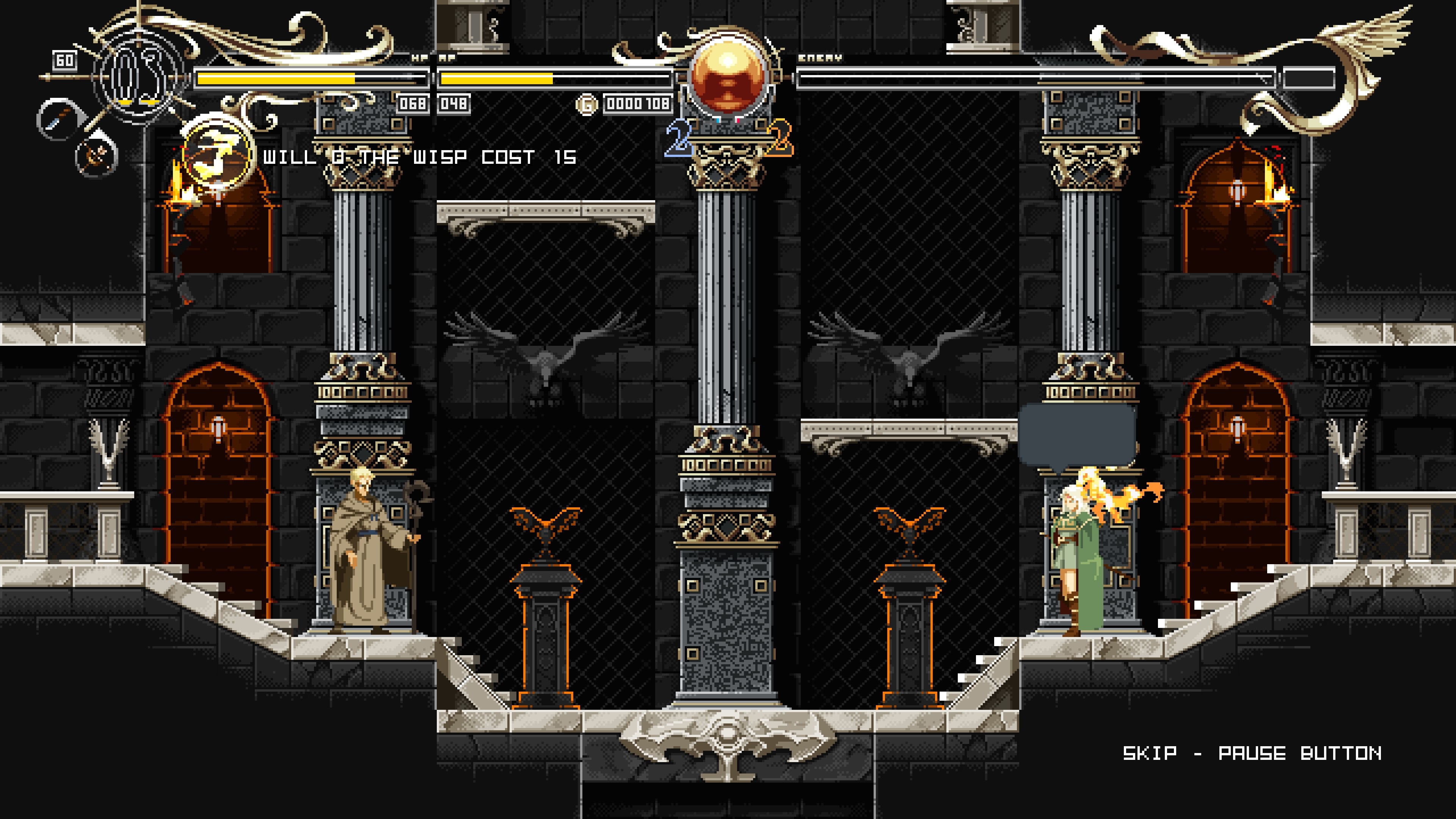
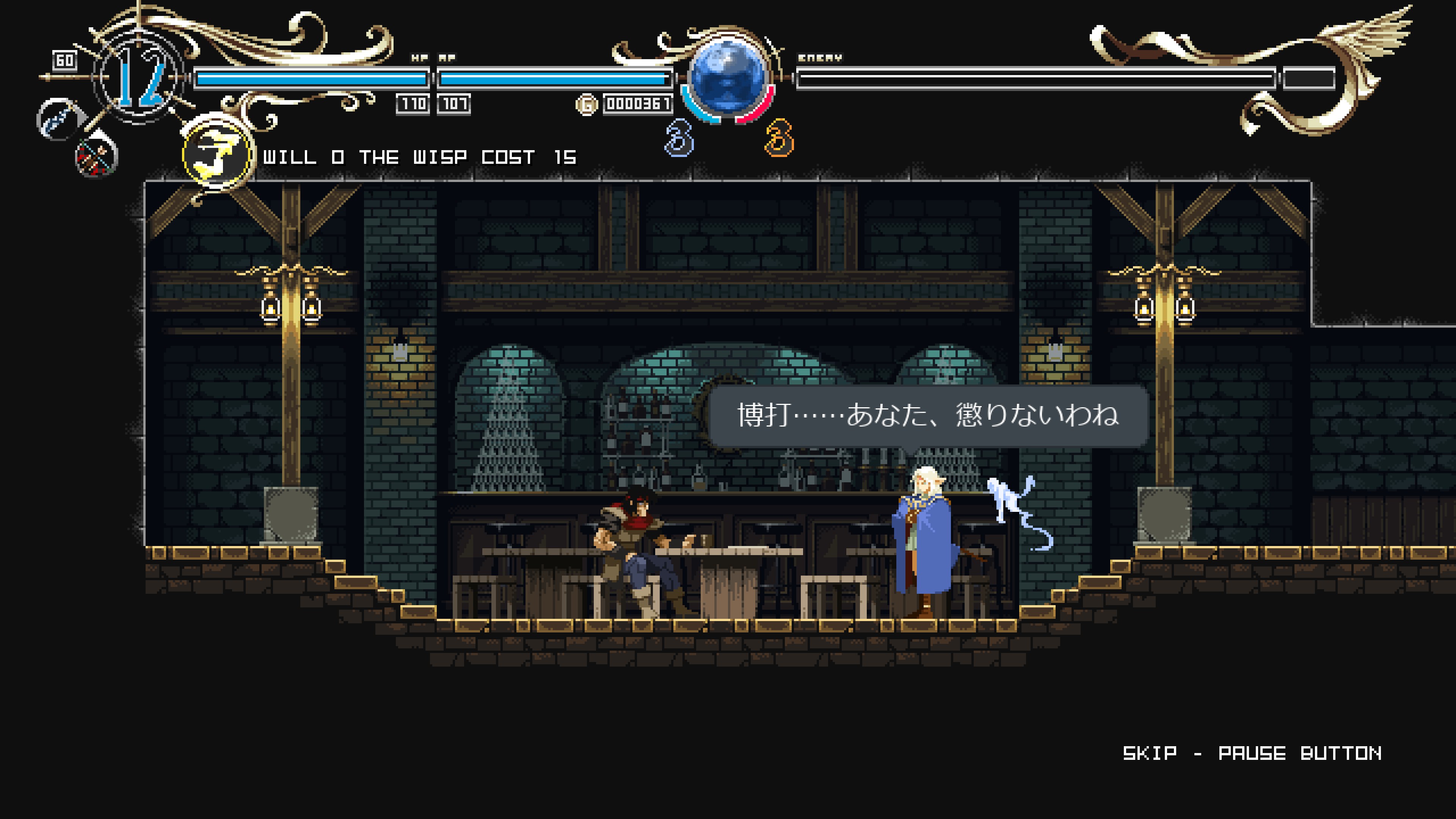
As promised, the premise of the game finds our Deedlit waking up in a labyrinth, her memory hazy and recollection of what she's doing here unclear. She explores to find her old friends present as well - except they're not quite acting right, and they seem to be in on something she isn't. But this labyrinth is full of monsters! Is Deedlit going to sit around and eat pizza? No: she's going to collect a variety of weapons and power-ups in a bout of recursive unlocking to get to the heart of what's going down here.
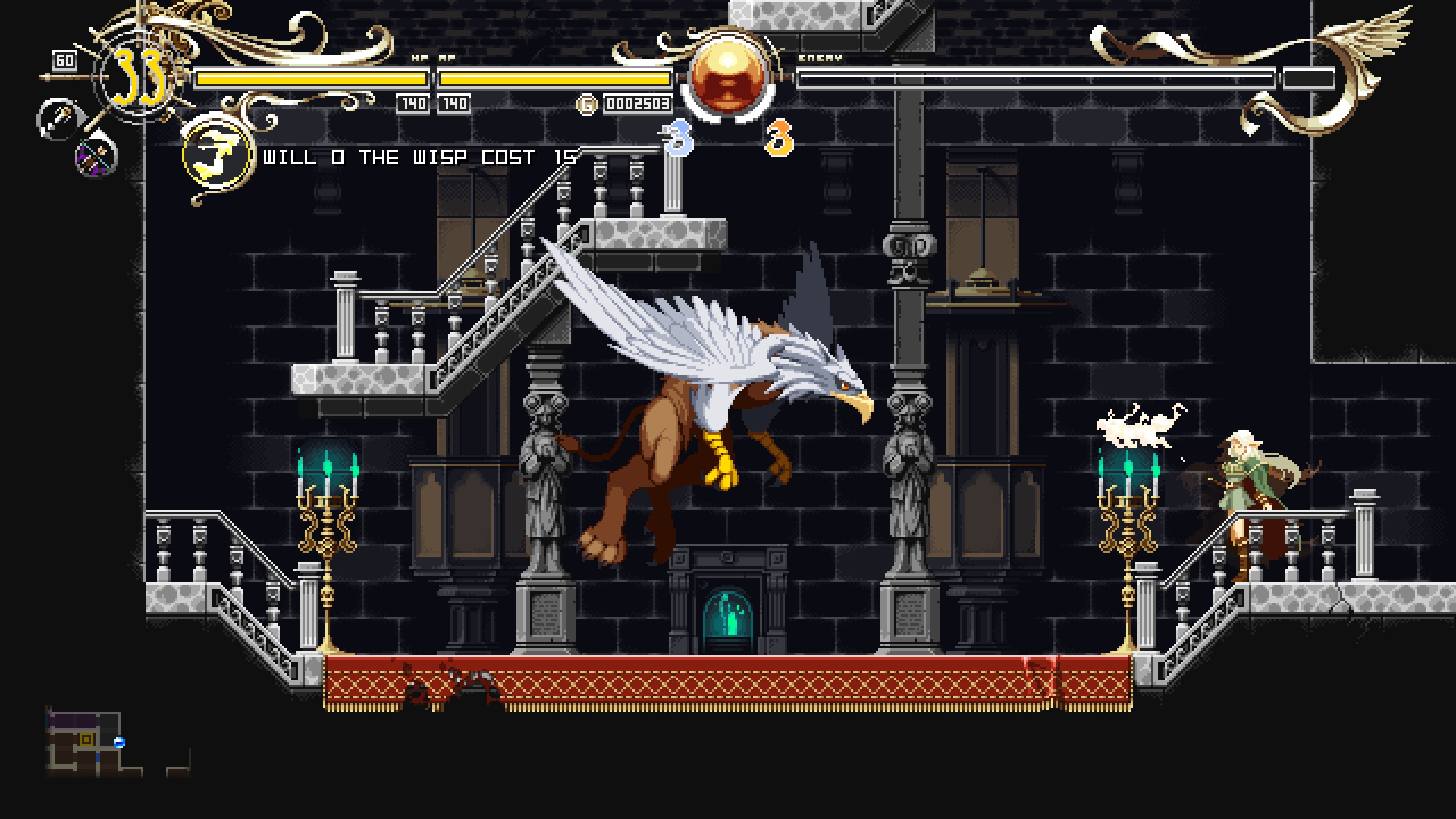
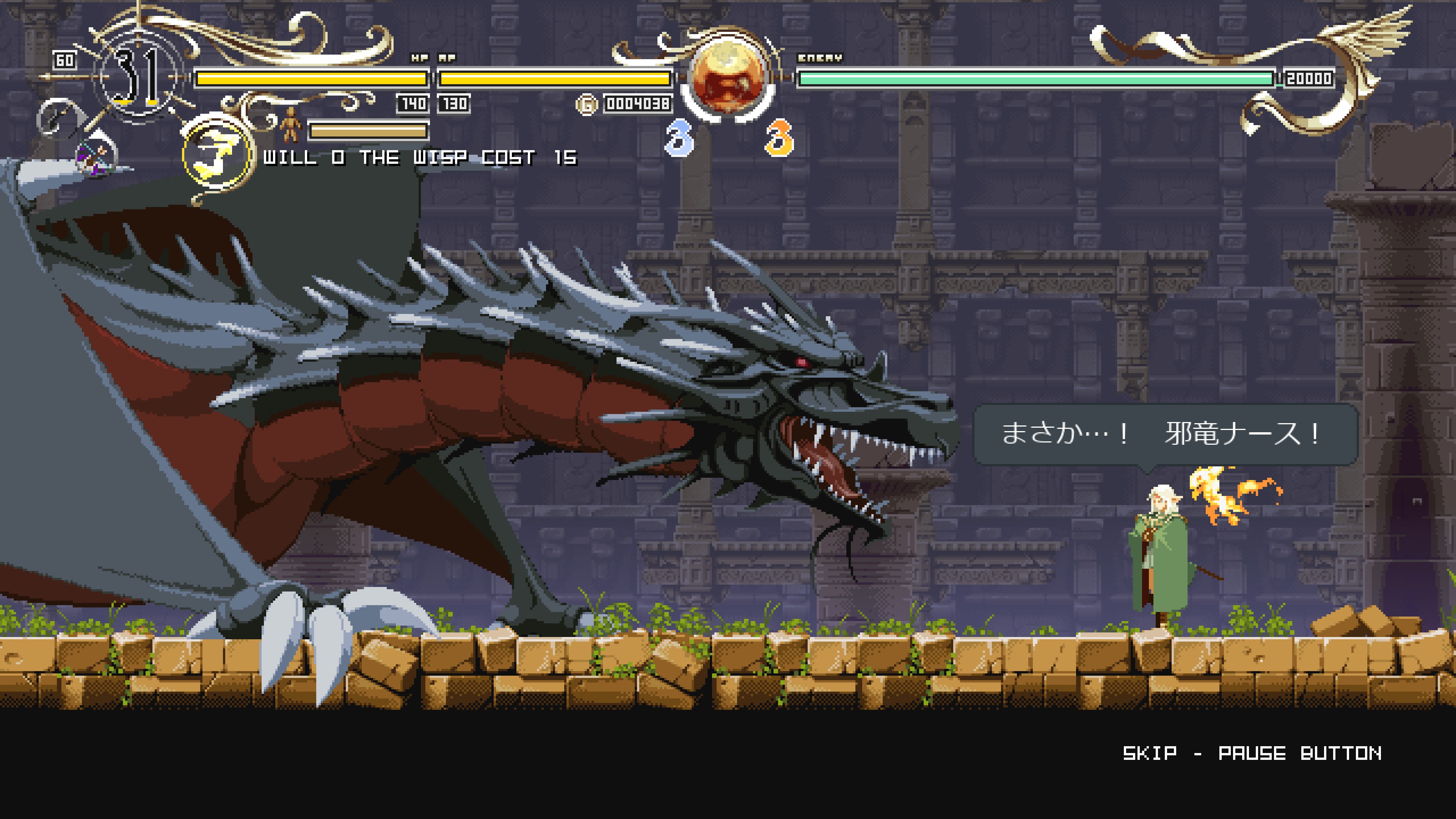
Now: while I recommend the game and have a lot of praise for the story, I found during the course of breaking down the title that I had a number of complaints, and there isn't a way into discussing Wonder Labyrinth that isn't going to make my recommendation here sound overly qualified. So let me say up front: this is a good, solid Metroidvania with fun gameplay and good (though frequently-borrowed) visuals, one that doesn't overstay its welcome, with a denouement that made me very glad I played it. If it's piqued your interest, get it; you'll be rewarded. Please keep that in mind during the discussion of strengths and weaknesses below.
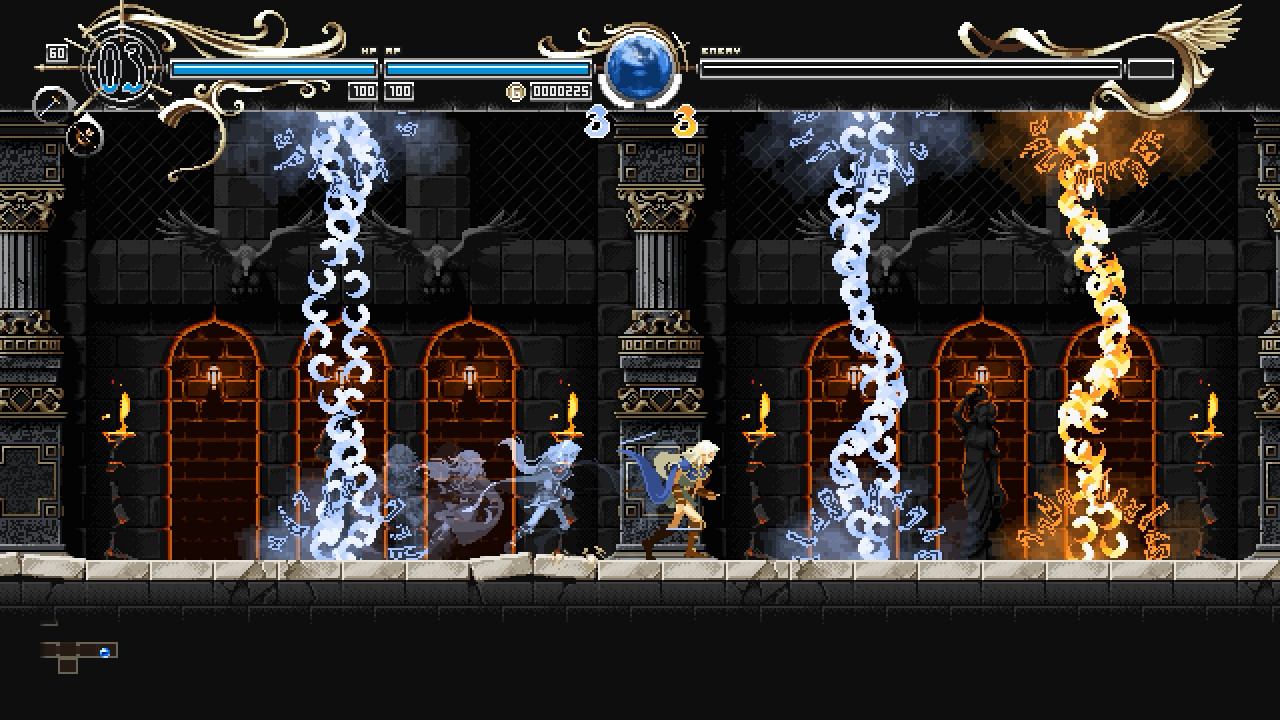
Taken from the official site; I have to hold down a second key to access the function row on my laptop, so I'm notably lacking in combat shots in my own screenshots.
While Wonder Labyrinth has beautiful sprite art, the first thing you'll probably recognize is the stuff stolen from everywhere else - startling with Deedlit herself, whose animation frames are very obviously traced over Alucard's from Symphony of the Night. Early bosses have their intros and attack patterns swiped from Order of Ecclesia and Shadows of Mystara. There's a lot of impressive work here - a lot of it, such as Deedlit's beautiful, whirlwind-wrapped triple jump - but the steals are so blatant and right up-front in the game's presentation that at every turn, I was wondering: is this impressive sight original, or just something I don't recognize because I haven't played the source?
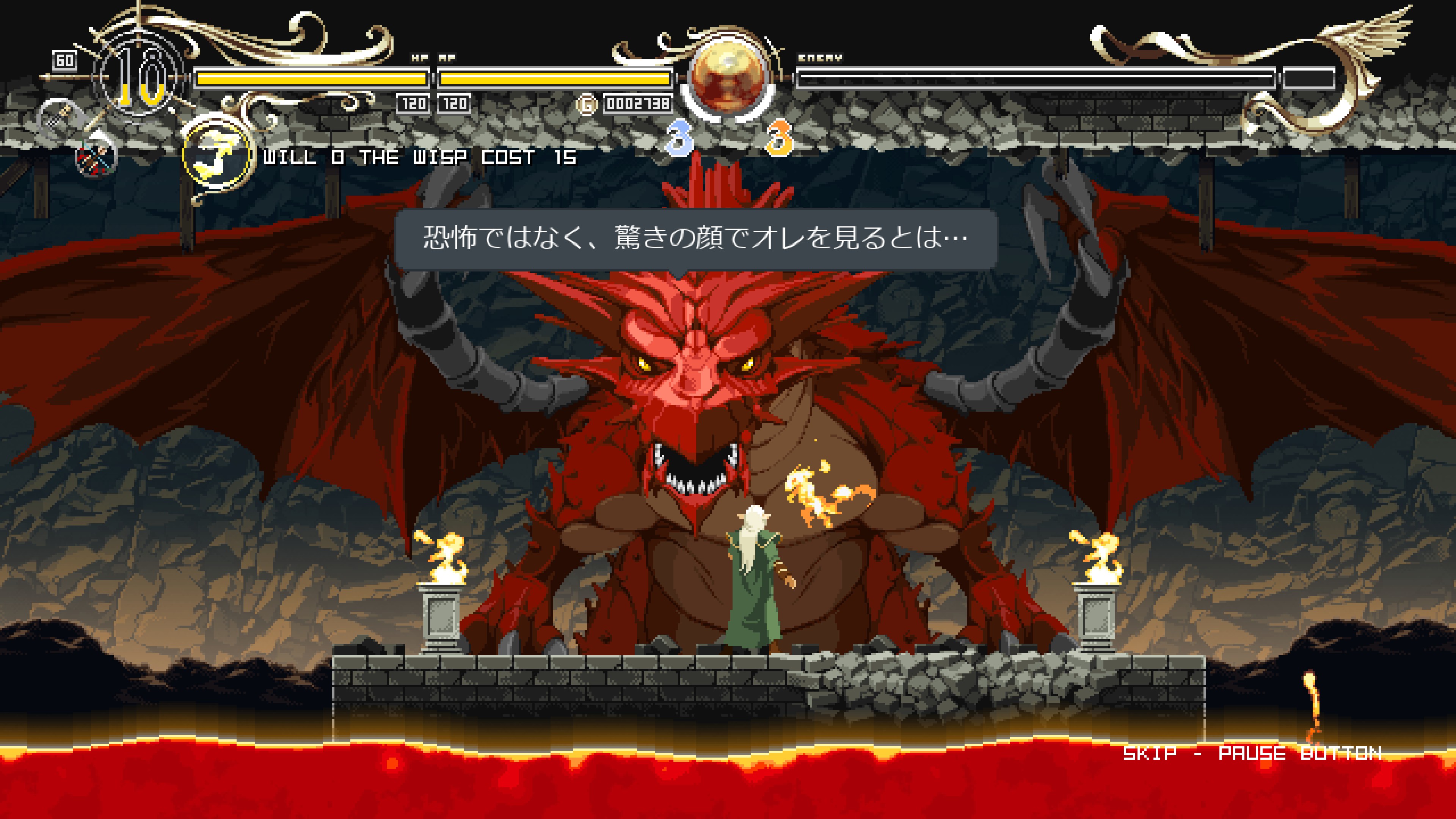
Mechanically, though, the game is on surer footing. Our elf protagonist, like everything in Lodoss, hews to fantasy archetypes, and while she'll spend much of the game swinging a bladed weapon - not only her trademark rapier but even quicker knives & catclaws, ranged shuriken & chakrams, and two-handed buster swords with devastating overhead strikes - her offense will rest more heavily on archery and magic than the average Metroidvania protag. Once you acquire a bow, you'll always have arrows at the ready, mapped to the one of the face buttons. While aiming is clunky - you hold down the button to plant Deed's feet and tilt her torso back and forth to aim in a rather limited cone, with no side switching and stiff animation that's swiped from the seraph enemies in Symphony's chapel - archery is a useful offensive option in several scenarios and offers a refreshing change of gameplay and mindset from melee combat. (I recall a boss battle that was initially cast as sword vs. sword but upon me remembering I had arrows completely changed character, from a tentative game of footsie to an exhilarating dodge-'em-up.) The game also features a number of light archery puzzles - ricocheting arrows off obstacles to strike targets & open doors, repeatedly hitting mechanisms from a moving platform to cross an expanse - that offer useful variety. I didn't always enjoy how it felt if more exact aiming than "straight ahead" was required, but despite the controls, the archery does add some welcome speed and spice.
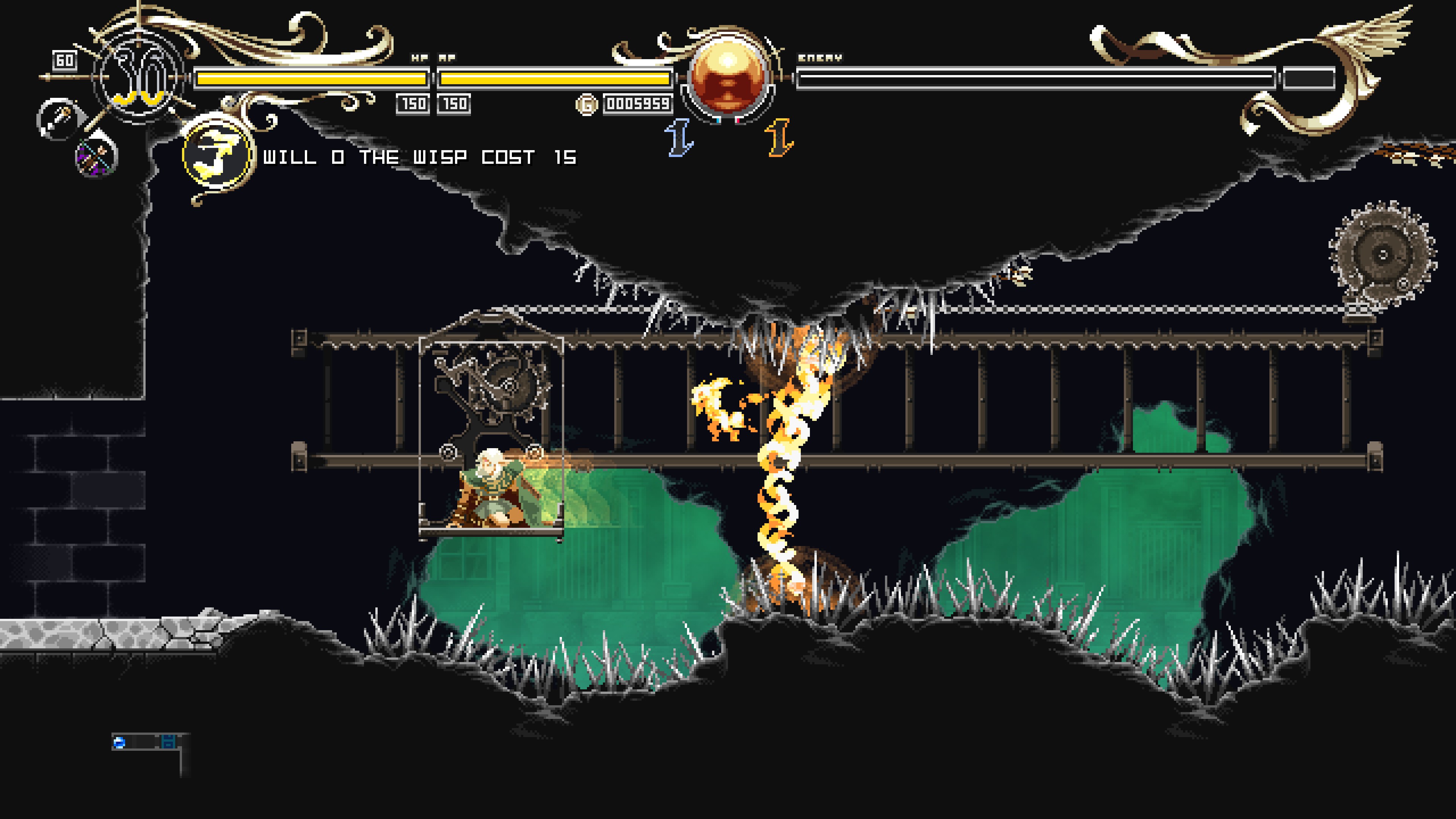
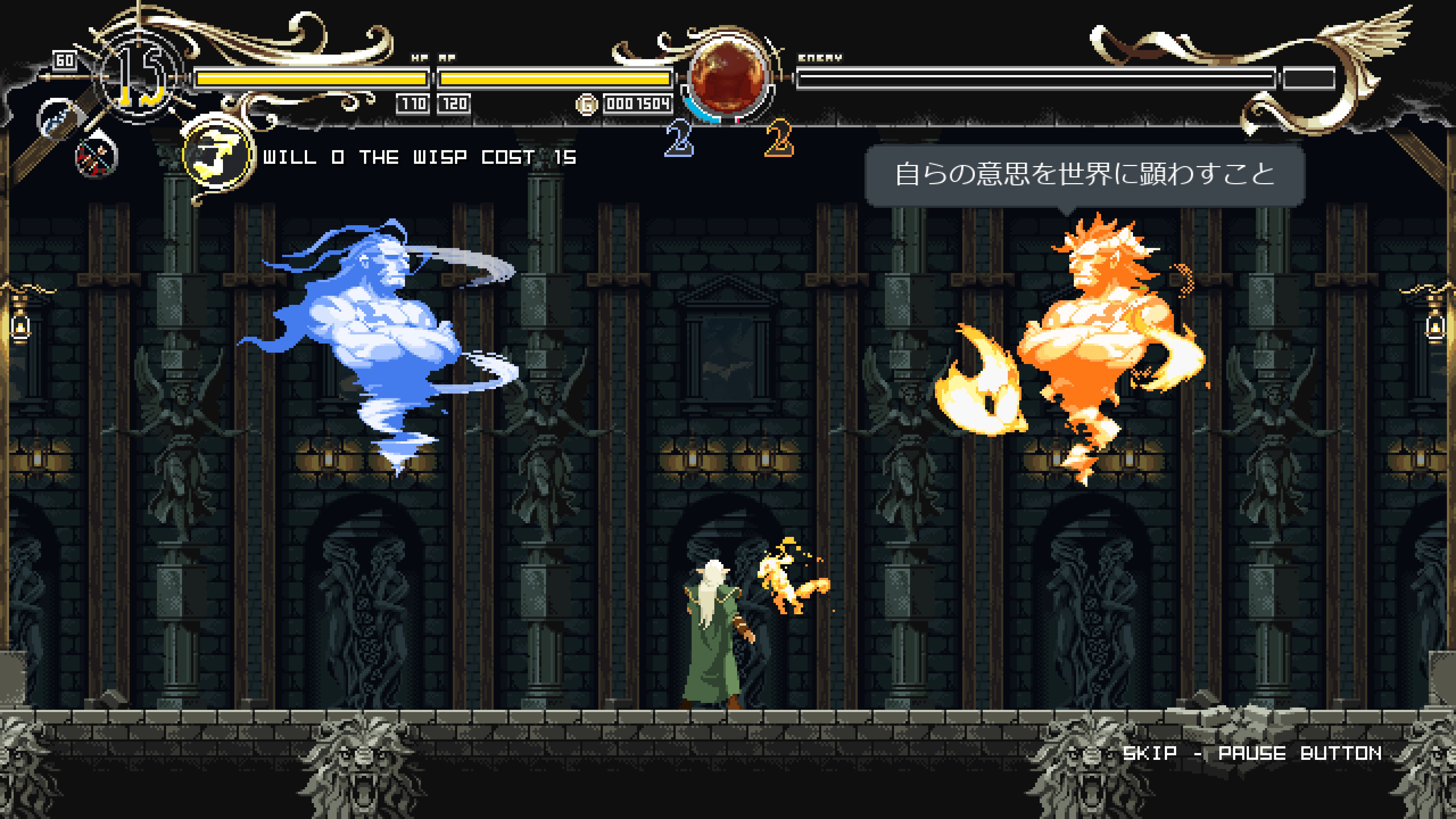
Magic revolves around an Ikaruga-like elemental system. After making their acquaintance very early in the adventure, Deedlit will always be accompanied by either a fire spirit or a wind spirit. Deedlit's primary weapon will be imbued with the elemental affinity of her current companion, which naturally affects how much damage she deals to enemies depending on their own alignments. She can also, though, nullify magic traps and enemy magic attacks and absorb them as MP if she has a spirit of the same element equipped. This becomes a particularly crucial tactic during boss battles, where rapid switching between spirits (it's mapped to a shoulder button) is necessary not only to survive but to fuel your own offense. The mechanic lends itself to show-stopping displays of enemy force and crazy spell patterns (that, yes, also share DNA with shoot-'em-ups), as well as hectic periods during regular exploration when enemies of opposing elements are clustered close together.
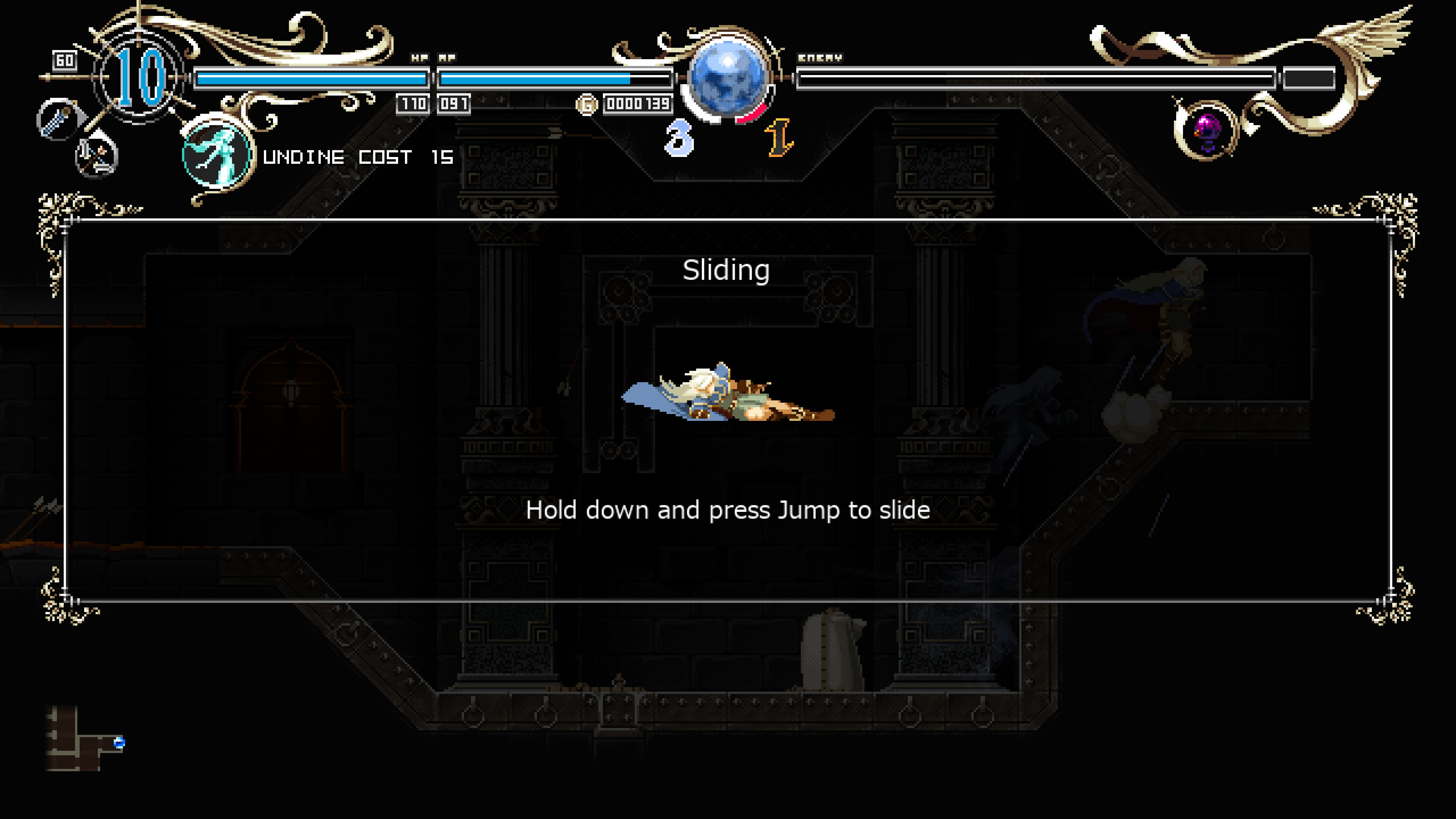
The spirits also bestow upon Deedlit a couple ancillary abilities: wind allows her to hover for a bit, while the fire endows her slide with an offensive kick. Though the kick remains entirely optional, the hover does figure into a few mobility puzzles where you'll need to switch nimbly between your wind-fueled hover and protection from fire-based traps. Sometimes it's hard to see what element you are in the heat of a pitched boss battle, where quick & constant switching is often required, but otherwise, in addition to powering puzzles, the elemental system adds a react-on-your-feet immediacy to gameplay and strongly distinguishes the title from other Metroidvanias. It's a showcase mechanic, and it works well.
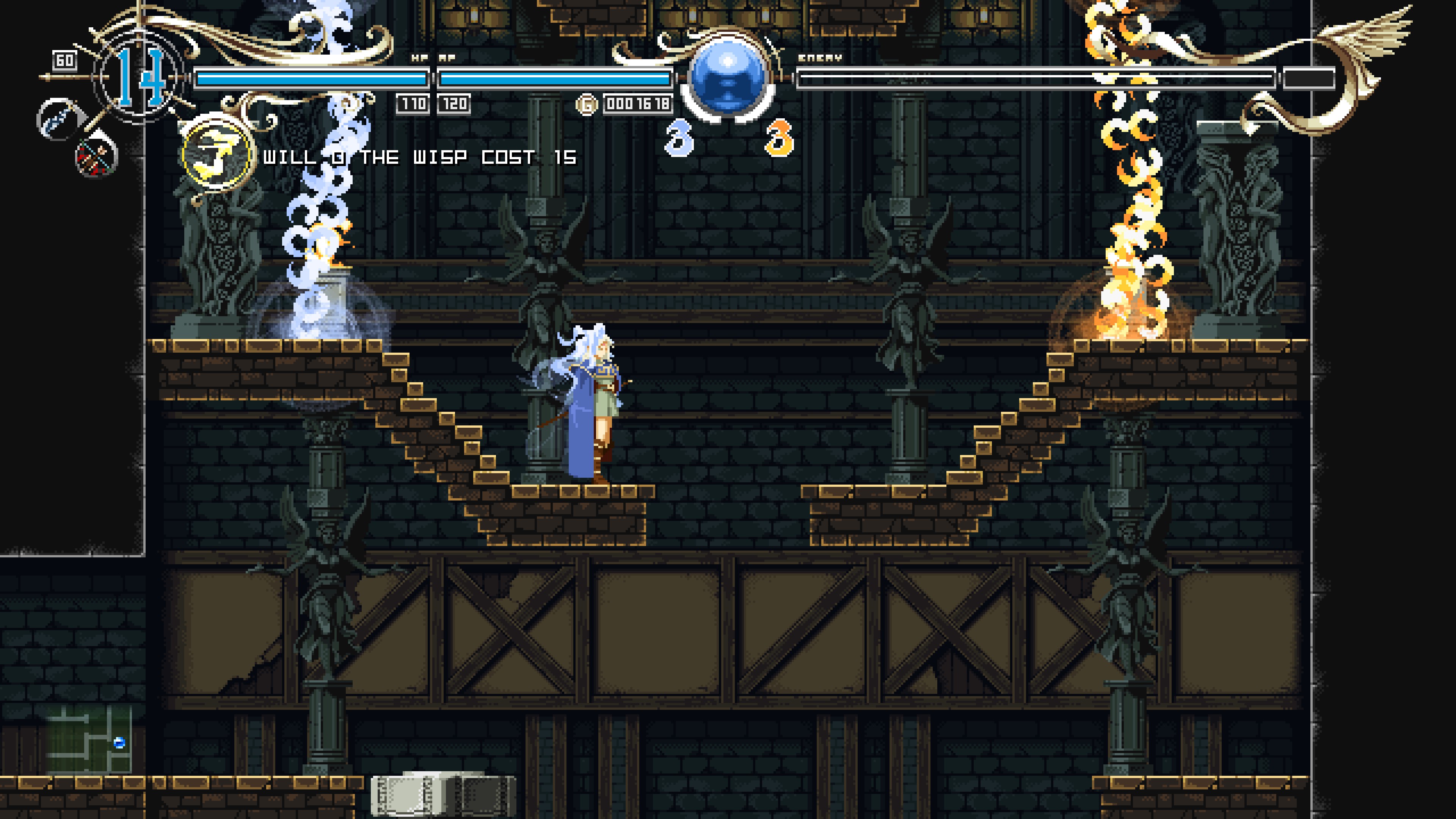
You also have just-plain offensive spells, mapped, like arrows, to a face button, and this actually causes a problem. The very first spell you get is a light-elemental several-shot homing attack that is massively, massively overpowered, to the point where it renders a number of the initial boss battles completely trivial. Things get a bit more balanced later on, but the spell remained a pillar of my offense, my #2 attack option after (and sometimes preceding) my basic melee. Deedlit can find several other spells with different attack patterns along her adventure, but I very seldom bothered with them outside a couple experimental casts, because the opening spell is just so powerful, and it homes. Props for making magic so viable in a basic-attack sense rather than an only-on-special-occasions sense, but the devs should have nerfed that spell a bit or reduced Deedlit's generous MP pool. Of course, I could have showed self-restraint, but what am I going to do when presented with a win button? Not use it?
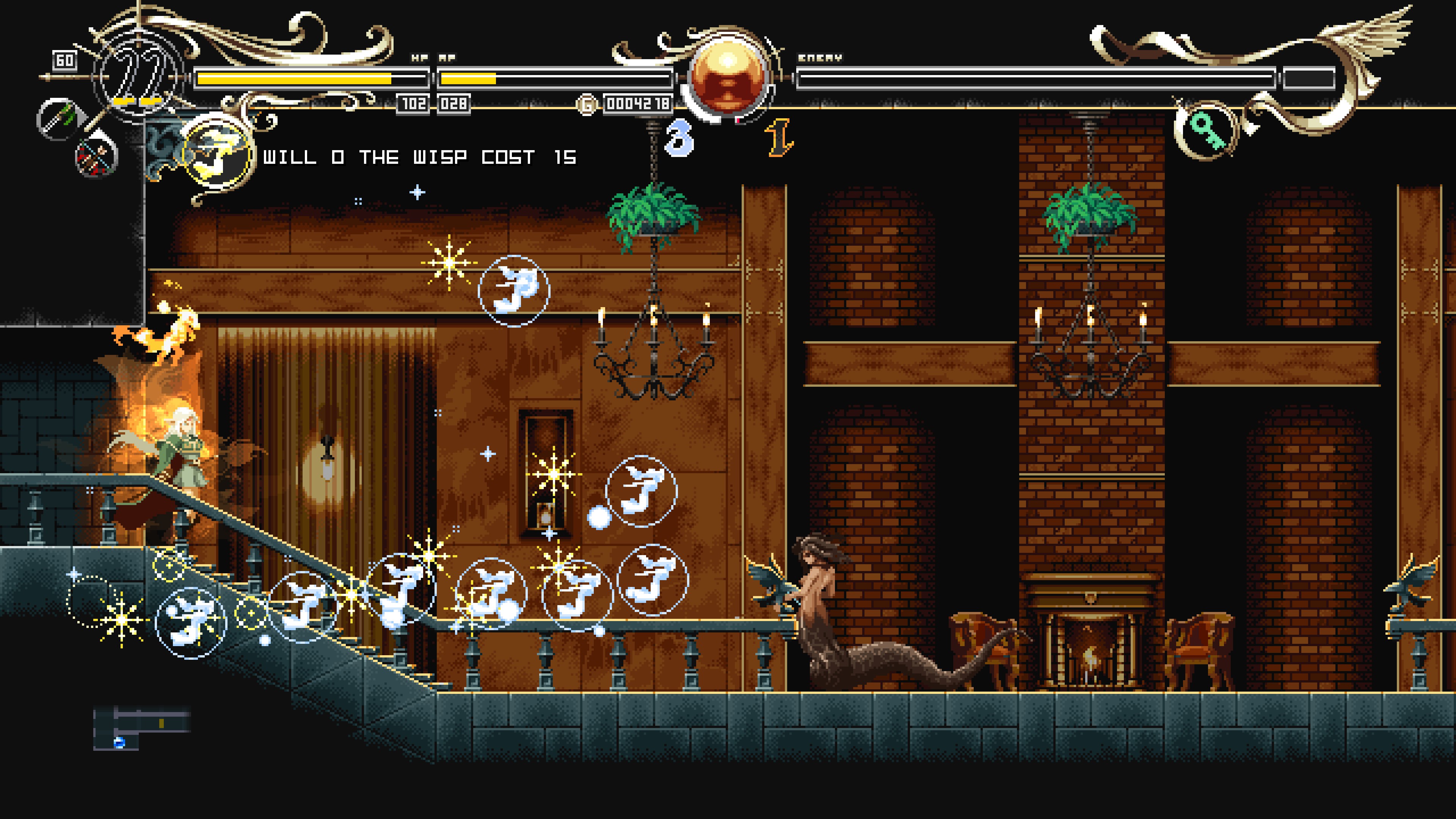
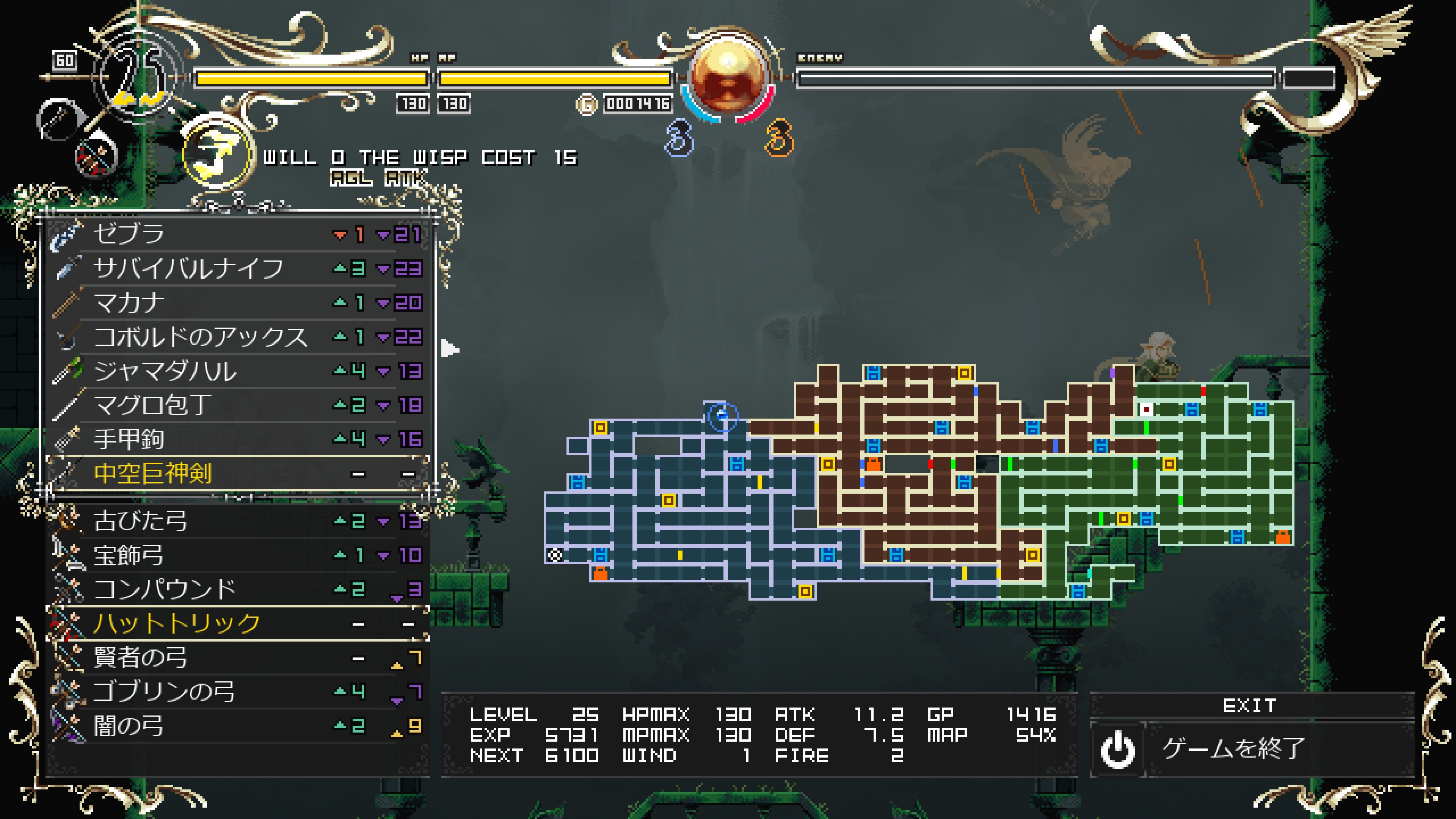
Structurally, the map is solid - it's relatively compact, as the game is about 8 to 9 hours, but large enough to be satisfying to unlock. I do wish there were more secrets: once you get an ability that opens up map area, there will be one or two rooms you can access elsewhere than in your immediate level, but there aren't any extensive alternate routes or significant goodies for creative explorers. Hidden stuff is generally restricted to one HP/MP pickup and a couple rooms with an extra weapon per level, with the breakable passages announced by telltale cracks. (Then again, though I did get 99% map completion, I've seen other players in post-game conversation reference a number of abilities & spells I completely missed, so maybe the failure is on my part here.) One point of praise: once encountered, barriers are marked on your map with color-coded notation for easy backtracking later, something I don't recall Castlevania ever doing.
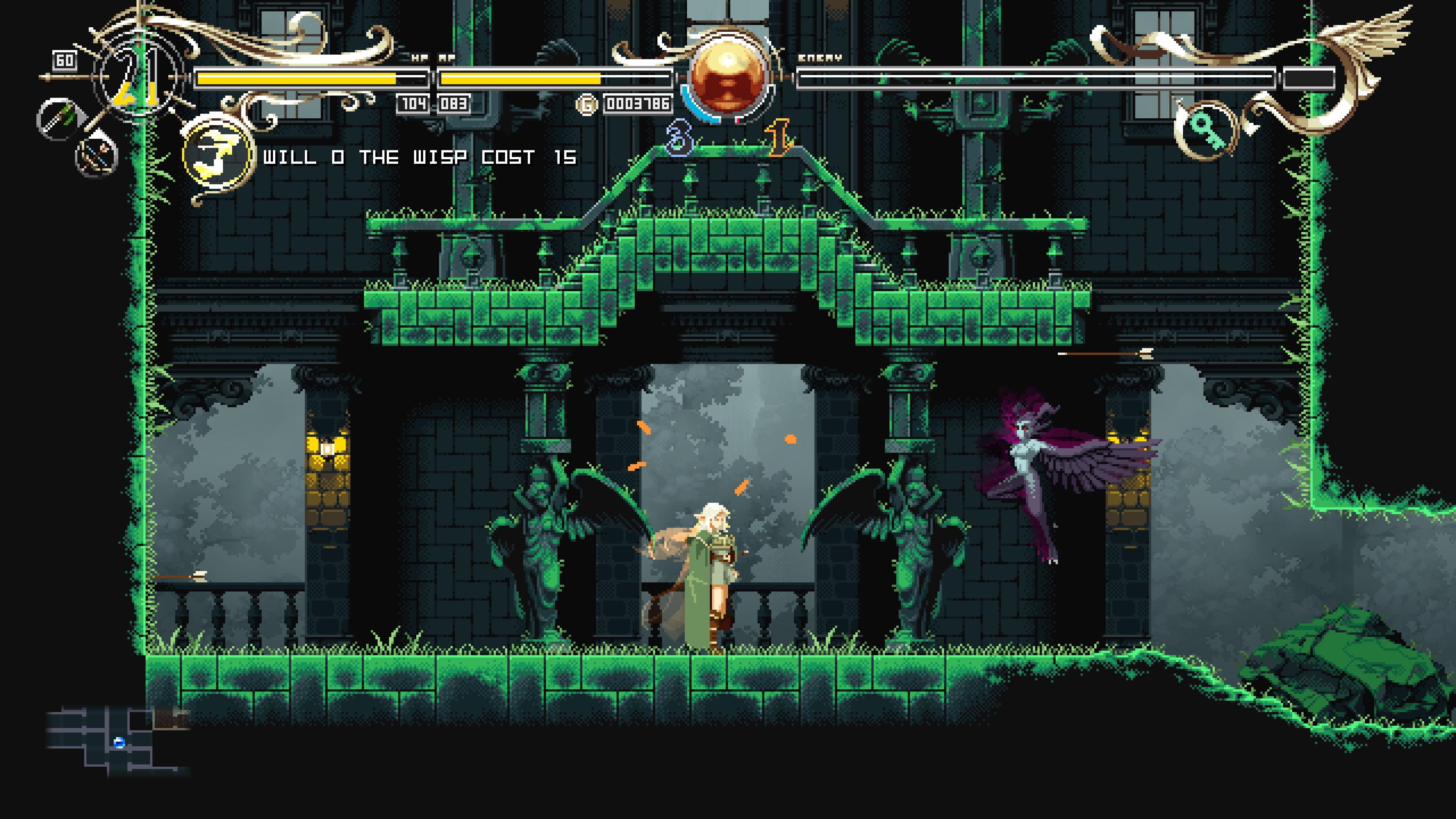
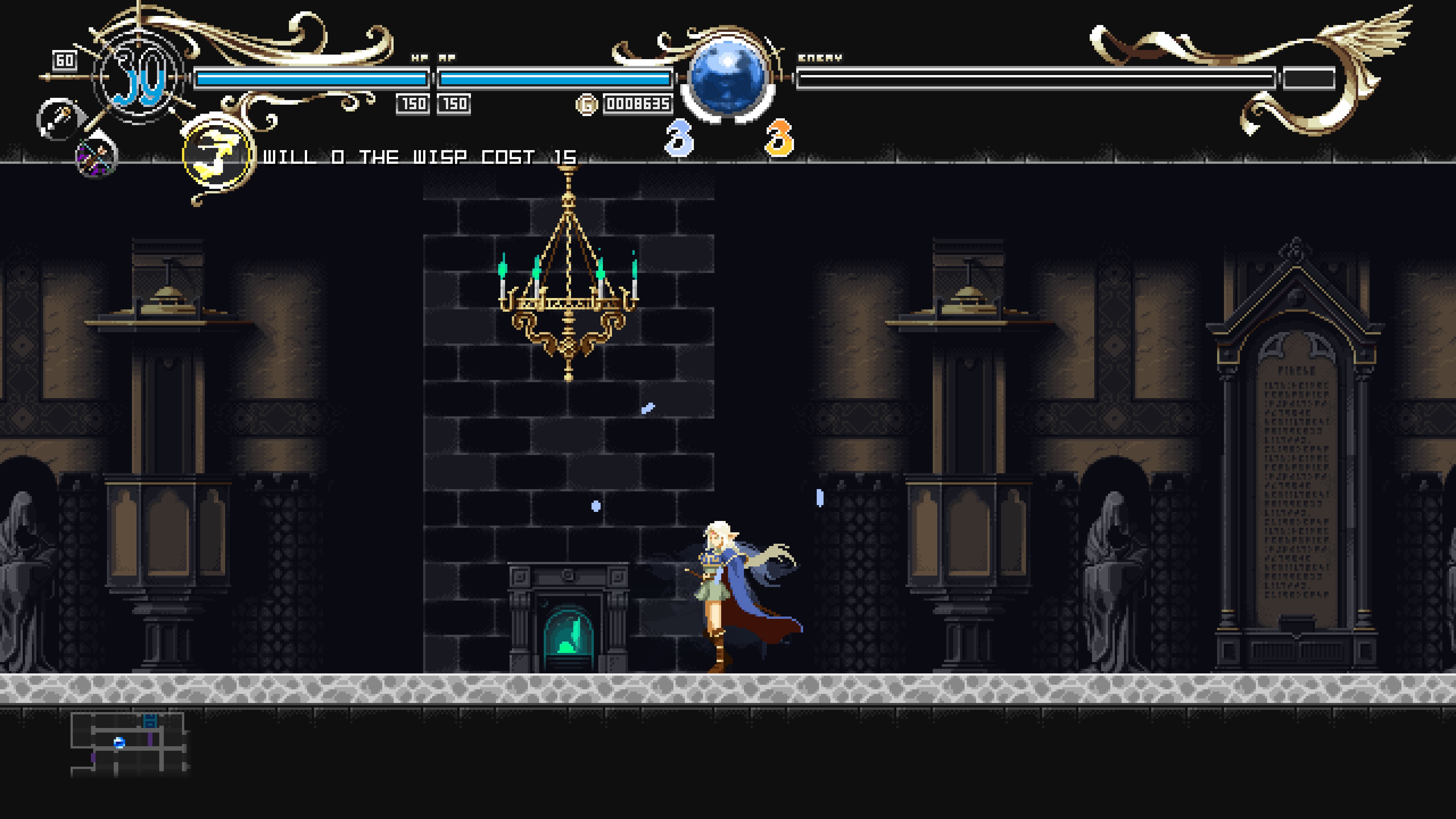
Getting back to aesthetics: while the individual details of sprite art itself are well-wrought, the levels could use a spark of originality. Even though the Metroid-like Castlevanias generally take place in the same location (Drac's castle), they still manage to offer memorable settings: a chapel framed against an open, racing sky, or a bone-bedecked museum of skeleton enemies, or Dracula's big Scrooge McDuck gold coin vault. The so-called Wonder Labyrinth has a few differences from level to level, but it's largely a bunch of dim stone galleries with various statues. Neat-looking statues, possibly-cadged statues, but the overall effect is a bit on the dour side nonetheless. Likewise, the music is OK but a bit unremarkable; it has the attitude and instrumentation of a Metroidvania OST but not the melodies to dig into your brain. Describing it as Castlevania Muzak is too mean, but it has the same unobtrusive, kind-of-going-nowhere qualities. It's not bad, but the game would benefit from it being better.
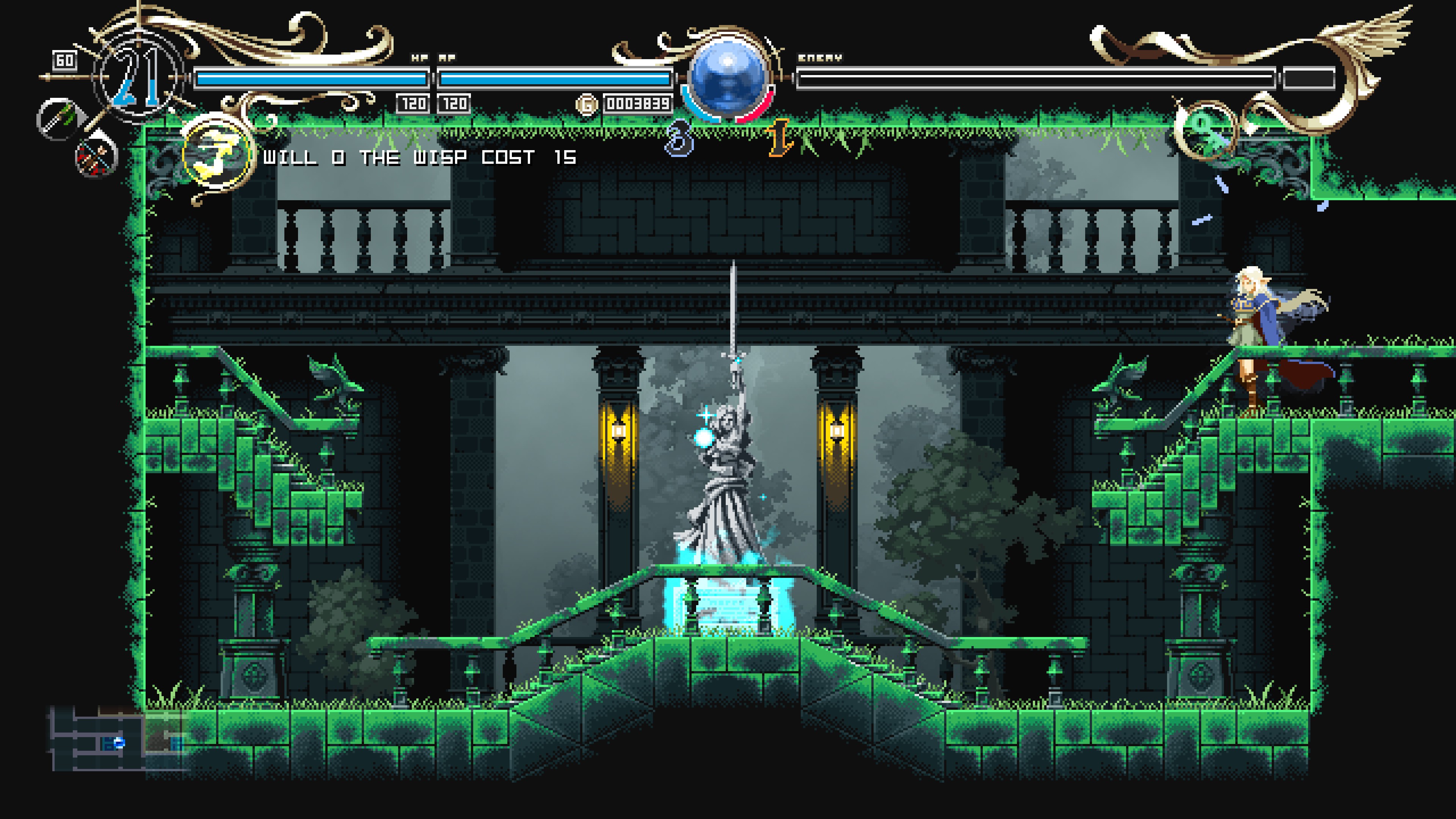
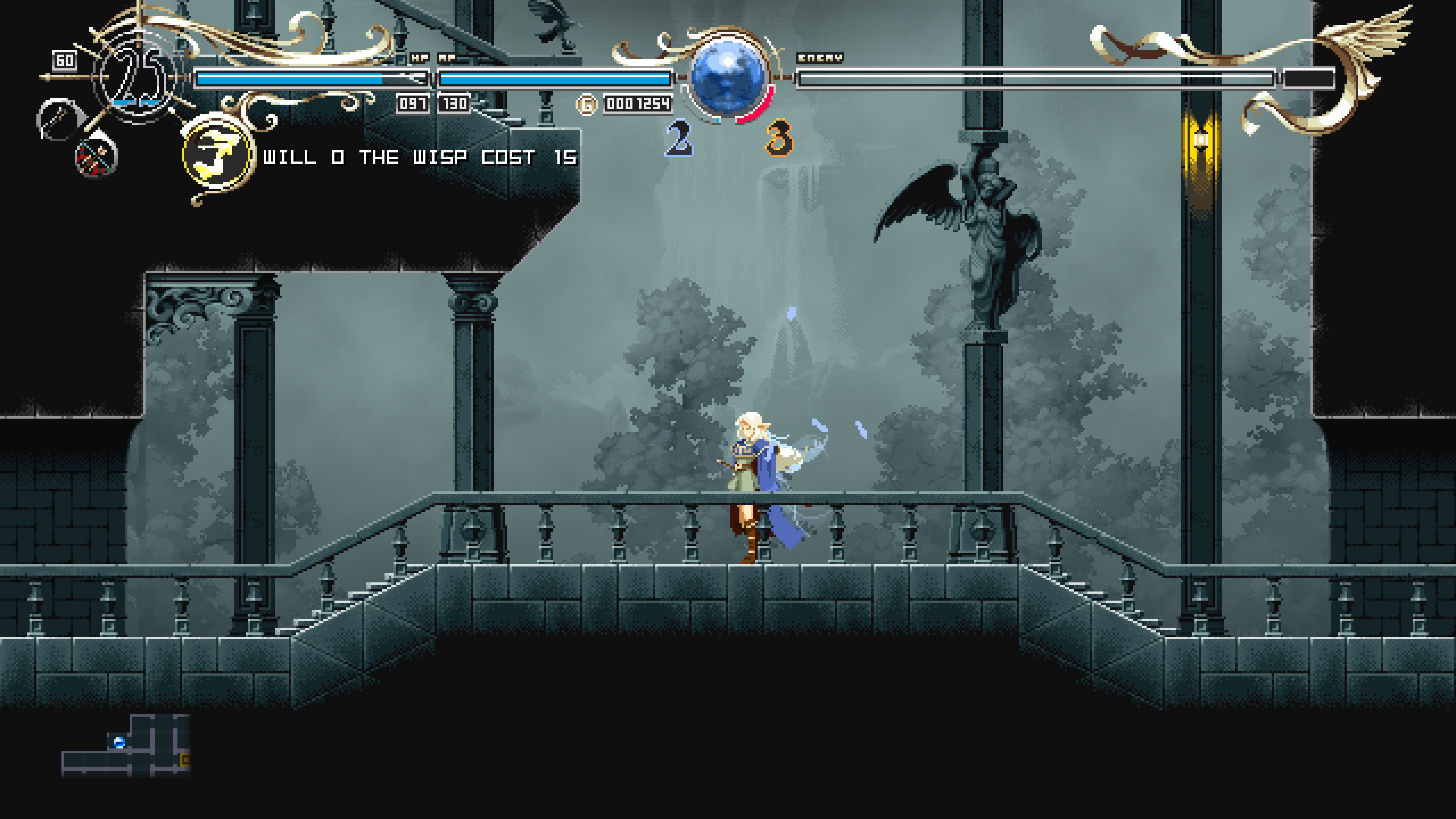
I think this is a byproduct of the devs coming from fan game production, notably the prodigious Touhou series; it's a professional production, but gamewise, the inspiration often isn't *quite* there, and they're still leaning too heavily on storied forebearers in the genre. They do, however, excel definitively in one aspect, and that's the ultimate destination of the story. Spoilers below.
Page 34 of 56
